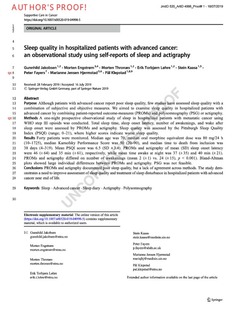| dc.contributor.author | Jakobsen, Gunnhild | |
| dc.contributor.author | Engstrøm, Morten | |
| dc.contributor.author | Thronæs, Morten | |
| dc.contributor.author | Løhre, Erik Torbjørn | |
| dc.contributor.author | Kaasa, Stein | |
| dc.contributor.author | Fayers, Peter | |
| dc.contributor.author | Hjermstad, Marianne Jensen | |
| dc.contributor.author | Klepstad, Pål | |
| dc.date.accessioned | 2020-02-17T13:37:21Z | |
| dc.date.available | 2020-02-17T13:37:21Z | |
| dc.date.created | 2019-11-25T13:01:35Z | |
| dc.date.issued | 2019 | |
| dc.identifier.citation | Supportive Care in Cancer. 2019, 1-9. | nb_NO |
| dc.identifier.issn | 0941-4355 | |
| dc.identifier.uri | http://hdl.handle.net/11250/2642034 | |
| dc.description.abstract | Purpose
Although patients with advanced cancer report poor sleep quality, few studies have assessed sleep quality with a combination of subjective and objective measures. We aimed to examine sleep quality in hospitalized patients with advanced cancer by combining patient-reported outcome-measures (PROMs) and polysomnography (PSG) or actigraphy.
Methods
A one-night prospective observational study of sleep in hospitalized patients with metastatic cancer using WHO step III opioids was conducted. Total sleep time, sleep onset latency, number of awakenings, and wake after sleep onset were assessed by PROMs and actigraphy. Sleep quality was assessed by the Pittsburgh Sleep Quality Index (PSQI) (range; 0–21), where higher scores indicate worse sleep quality.
Results
Forty patients were monitored. Median age was 70, median oral morphine equivalent dose was 80 mg/24 h (10–1725), median Karnofsky Performance Score was 50 (20–90), and median time to death from inclusion was 38 days (4–319). Mean PSQI score was 6.5 (SD ± 3.4). PROMs and actigraphy of mean (SD) sleep onset latency were 46 (± 64) and 35 min (± 61), respectively, while mean time awake at night was 37 (± 35) and 40 min (± 21). PROMs and actigraphy differed on number of awakenings (mean 2 (± 1) vs. 24 (± 15), p ˂ 0.001). Bland-Altman plots showed large individual differences between PROMs and actigraphy. PSG was not feasible.
Conclusions
PROMs and actigraphy documented poor sleep quality, but a lack of agreement across methods. The study demonstrates a need to improve assessment of sleep quality and treatment of sleep disturbance in hospitalized patients with advanced cancer near end of life. | nb_NO |
| dc.language.iso | eng | nb_NO |
| dc.publisher | Springer | nb_NO |
| dc.title | Sleep quality in hospitalized patients with advanced cancer: an observational study using self-reports of sleep and actigraphy | nb_NO |
| dc.type | Journal article | nb_NO |
| dc.type | Peer reviewed | nb_NO |
| dc.description.version | acceptedVersion | nb_NO |
| dc.source.pagenumber | 1-9 | nb_NO |
| dc.source.journal | Supportive Care in Cancer | nb_NO |
| dc.identifier.doi | 10.1007/s00520-019-04998-5 | |
| dc.identifier.cristin | 1751878 | |
| dc.description.localcode | This is a post-peer-review, pre-copyedit version of an article. Locked until 7/8-2020 due to copyright restrictions. The final authenticated version is available online at: https://doi.org/10.1007/s00520-019-04998-5 | nb_NO |
| cristin.unitcode | 1920,12,0,0 | |
| cristin.unitcode | 194,65,15,0 | |
| cristin.unitcode | 194,65,30,0 | |
| cristin.unitcode | 1920,16,0,0 | |
| cristin.unitcode | 194,65,25,0 | |
| cristin.unitcode | 1920,28,0,0 | |
| cristin.unitname | Kreftklinikken | |
| cristin.unitname | Institutt for klinisk og molekylær medisin | |
| cristin.unitname | Institutt for nevromedisin og bevegelsesvitenskap | |
| cristin.unitname | Nevroklinikken | |
| cristin.unitname | Institutt for sirkulasjon og bildediagnostikk | |
| cristin.unitname | Klinikk for anestesi og intensivmedisin | |
| cristin.ispublished | true | |
| cristin.fulltext | postprint | |
| cristin.qualitycode | 1 | |
